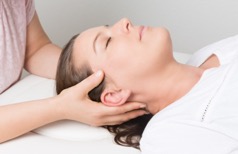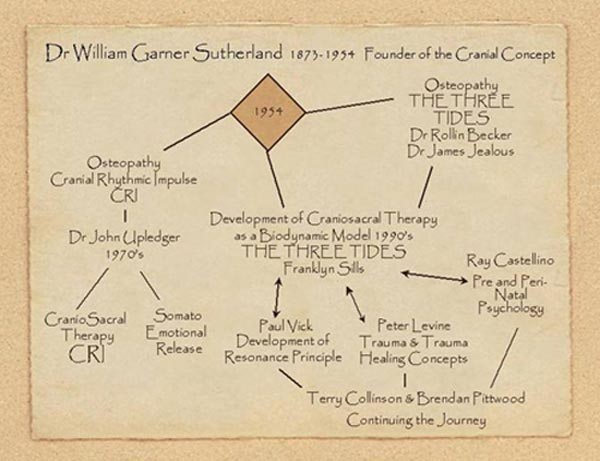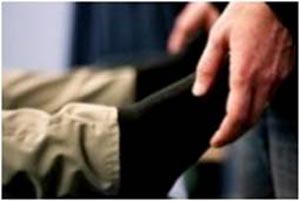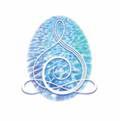
Biodynamic (and Resonant) Craniosacral Therapy is a very gentle, non-invasive holistic therapy that assists your body's natural capacity for self-repair. It is a whole-body therapy and therefore includes every aspect of you and your health rather than just your head and tail as the name suggests!
'Biodynamic Resonance' relates to the therapy being wholly client-led, which means that your body's "Inherent Treatment Plan" is safely supported by the energetic environment created by the therapist, without the use of suggestion or manipulation.
Biodynamic Craniosacral Therapy began in the USA from the later discoveries and research of the founder of Cranial Osteopathy, Medical Physician and Osteopath Dr William Garner Sutherland DO (1873 - 1954). Dr Sutherland's many years of research and observations of the body's subtle physiology led to his discovery of a rhythmic tide-like movement within all the cells of the body, which is vital to life.
A trained therapist easily perceives this 'craniosacral' motion, and where there is loss of motion or vitality it is often the source of a health challenge. Further development of Dr Sutherland's discoveries has refined the therapy and it has unfolded into the unique style of deep unconditional "listening" that it is today.
"Allow physiologic function within to manifest its own unerring potency rather than apply a blind force from without." Dr W G Sutherland
Our approach, being non-suggestive, without intention nor manipulative, even in a very discrete way, therefore opens up the training and practice to people who are not a professional doctor or therapist. In some respects, it can be an asset to be without experience of fixing patients through intentional therapies. It is a therapy where the interconnectedness of mind, body and spirit are wholly acknowledged.
"When your body is heard it more easily and effectively finds its way to health." - TLC
The therapy has evolved since its beginnings in Osteopathy from the mid-1800s with the work and teachings of the founder of Osteopathy, Dr A. T. Still (1828 - 1917). Through family tragedy, Dr Still realised the limitations of medicine as the healer and, just as an aside, he prophesized the extent of the legal and illegal drug culture of today. He developed the art and science of Osteopathy, which was initially non-manipulative, as a way to support the body's own healing potential. For example, about the importance of the cerebrospinal fluid, Dr Still wrote:
"Cerebrospinal fluid is the highest known element that is contained in the human body and unless the brain furnishes this fluid in abundance a disabled condition of the body will remain.
He who is able to reason will see that this great river of life must be tapped and the withering fields irrigated at once or the harvest of health be lost forever."
Dr William Garner Sutherland, one of Dr Still's students, was a profoundly spiritual man who developed an approach to Osteopathy known as the “Cranial Concept”.
In almost all books about Craniosacral Therapy, there is some mention of the lifetime work of Dr Sutherland who, from the age of 25 until his death in 1954 at age 81, researched the inner workings of the human system.
As the story goes, when Dr Sutherland was just a student the bones of the cranium fascinated him because although he was taught that they were fused by adulthood it made no sense because skulls could be disarticulated and cranial bones had sutures that seemed to be designed for movement. While looking at a temporal bone, as he described it, a thought struck him, "bevelled like the gills of a fish for primary respiration." This thought led him on his lifetime journey to discover its nature.
He tried to prove that cranial bones were fused because if they were designed for movement this would have immense implications and a challenge of everything that was "known" at that time. He undertook investigations, which included his crazy baseball cap and bandages that earned him the nickname "Wild Bill." These investigations proved to him beyond doubt that the living skull expresses motion and that this motion is physiologically important.
In the early years Cranial Osteopathy began as strongly manipulative and, with some refinements, may still be practiced by some practitioners in this way today. However in the latter years of his research and inspired by his teacher Dr Still to believe in the body's ability to heal itself, Dr Sutherland refined and practiced healing through trust in the Innate Intelligence of the body. He pointed to the deep spiritual roots found within the human condition.
An example of the effect of our energetic impact on health is the unexpected 'healing' story of the experience of famous Psychiatrist Dr Elisabeth Kubler-Ross (1926 - 2004). She discovered how a hospital cleaner's stillness of being and presence in the room of an aggressive palliative care patient, had a profoundly beneficial effect on that patient's emotional wellbeing. This story also underlines the vital practice of the doctor’s attentive listening “bedside manner” that largely seems to have been abandoned. Bernard Lown, the famous Boston cardiologist, wrote in 1996 in his book The Lost Art of Healing how essential bedside behaviour is to good medical care. He expressed his concern that important bedside skills are disappearing in our technology-focused practice of medicine. The accomplished doctor is said to have a bedside manner that is humane and compassionate, empathetic and supportive, and as Dr Kubler-Ross’s experience reveals, this “bedside manner” is an integral part of the healing process.
Discoveries and hypotheses, from the great thinkers and researchers of modern history, support Dr Sutherland's own discoveries. For example, in the 1600 and 1700's, Christian mystics, such as Emanuel Swedenborg, put forward many physiological theories from research and intuition, which have since been confirmed by medical science. Just a few of Swedenborg's hypotheses were about the circulation and existence of the cerebrospinal fluid; that the motion of the brain was separate from respiration; "... that the smallest organic particles are independent centres of forces endowed with individual life."
There are many accounts of the history and development of biodynamic craniosacral therapy available on the Internet and in the increasing number of books published over the last decade or so. One story, edited from Franklyn Sills' website www.karuna-institute.co.uk, is shared below to highlight a pivotal point in Dr Sutherland's move away from the mechanical fix-it approach to healing.. Please note that the words “inhalation” and “exhalation” in the account below relate to the movements of the cells and tissues of the body and are not associated with, nor are in rhythm with respiratory breathing:
"In 1945, at the age of 72, Dr Sutherland had an extraordinary experience that transformed his understanding of the work, his approach to healing and the language he used. He was called to the bed of a dying patient who was in great pain. As Sutherland held the man's system, a depth of stillness arose and he had a direct experience of what he called the 'Breath of Life' as his patient peacefully died.
Sutherland began to focus on 'primary' respiration and its inhalation/flexion and exhalation/extension phases and he wrote about an approach where no outside force is used, but the unerring potency, or life force, is trusted to initiate and carry out healing processes.
What the body needs to happen for healing to take place cannot be achieved by the practitioner's analysis or motion testing. It is about what Sutherland called the 'Intelligence of the system' and the 'intention of the Breath of Life'. At its deepest level, work in this field casts us into the mystery of life itself."
Over the years Biodynamic Craniosacral Therapy has become a discrete discipline. It is a gentle, non-invasive way of effectively working with the physical, emotional and energetic aspects of the body and its history. The way of 'being' of the practitioner to support health and healing without trying to fix the problem is not new. In the natural order of things as this work developed, some notable practitioners in the field returned to the roots of osteopathy, the later discoveries of Dr Sutherland and even further back to ancient teachings.
Recent History
Until the single-minded and pioneering work of Physician and Osteopath Dr John Upledger in the 1970's, Cranial Osteopathy remained in the hands of a few interested Osteopaths such as Dr Rollin Becker DO (1910 - 1996), whose inspiring work and writings offer us much insight into Sutherland's discoveries, and into cranial osteopathy and biodynamic concepts. The 'cranial' community owes a debt of gratitude to Dr Upledger (1932 – 2012) who offered his 'CranioSacral Therapy' work to practitioners outside of the osteopathic profession.
In 1982 Maura and Franklyn Sills established the Karuna Institute in Devon, where Franklyn began his apprenticeship in Osteopathy. Over the years he redefined craniosacral therapy in terms of a field of practice in its own right and now teaches "Craniosacral Biodynamics". He is the author of "The Polarity Process", which came from his Polarity Therapy studies with Randolph Stone in the late 1970s, and many books on the subject of Craniosacral Biodynamics that reflect the ever-unfolding nature of this work.
The name 'biodynamic' refers to working with the energies that create and maintain life and is what was meant in the name given to it by the first group of farmers inspired by Rudolf Steiner to put the new method to field-use and practical tests, deciding to call it "Biodynamic" from two Greek words "bios" (life) and "dynamis" (energy). The word 'method' indicates that it was not just about the production of another fertilizer, biodynamic and organic though it was, but rather that certain principles are involved, which in their practical application secure a healthy soil and healthy plants - which in turn produce healthful food for man, and healthy feed for animals.
The word 'biodynamic' is believed to have been first used in the cranial field by Dr Rollin Becker, who used the term to describe the action of the potency of the Breath of Life. James Jealous DO also uses 'biodynamics' to describe his work, which he teaches exclusively to medical doctors and Osteopaths.
Cranial Resonance
Paul Vick trained to teach with Franklyn Sills in the early 1990s in the UK, and subsequently taught with Franklyn for many years in London and at the Karuna Institute in Devon. They established the Craniosacral Therapy Education Trust (CTET) with Paul as the principal teacher and course director. Following the call to take the training overseas, Paul began a training school in the late 1990s, which is now called Resonance Trainings, www.resonance.org.uk
Paul continued to further the development and teaching of BCST with the Resonance principle in such a way that Cranial Osteopaths have commented that his teachings offer an exciting new depth of approach to the work.
Paul describes "Cranial Resonance" as a meeting place or place of concord:
"This way of working promotes the natural healing forces within the body to be the active agent of change. Cranial Resonance is the foundation of a healing relationship and is the key for understanding another person's experience. It is a state of receptive presence. When we are empathetic, distance, as we normally experience it, ceases to exist, and we come into a Rhythm of Presence."
It is no mean feat to embody the skills of this 'healing relationship' as there is often so much of our own "stuff" that can get in the way. Our unique way of teaching supports us all to make sense of our behaviours and imprinting offered by life experience so that we may better consciously utilise this in support of deepening our skill as efficacious and heart full therapists.
Coming to a resonant way of Be-ing takes time and practice as well as a willingness to be a neutral witness, to be humble, without judgement and foremost to come from the heart. We trust the process and the Intelligence of the system as well as to let go and embrace Sutherland's words:
"Trust the Tide."
History in Australia and New Zealand
Paul Vick was invited to head a practitioner training that completed in New Zealand in 2000. The training included four enthusiastic craniosacral therapy tutors from the UK, and three of these tutors assisted Paul in the second training in New Zealand and first Australian training, completing in 2003. They included Sheila Kean, Ged Sumner who taught with CTET, and Colin Perrow who was a course director at the Karuna Institute.
Paul's intention for the teaching was to train tutors to continue his work "down under" and for him and the Australasian tutors to continue to support graduates with a comprehensive postgraduate programme.
The Birth of Stillness Trainings

After many years of training with Paul Vick and the Resonance Trainings team, the International team of Stillness Trainings tutors was established in 2007 with Terry Collinson and Brendan Pittwood as tutors and Evonne Bennell in administration. We offer Introductory, Diploma, Advanced Diploma, Postgraduate and associated workshops and courses in the biodynamic and resonance approach to craniosacral therapy. These 'associated workshops and courses' are not only based on biodynamic and resonance principles but also on development from Terry Collinson's training in Reiki and metaphysical causation of disease, and Brendan Pittwood's Pre and Peri-Natal Psychology training with Dr Ray Castellino DC. Both Terry and Brendan are committed to the effective use of language skills in therapeutic practice and teaching and reflect the practice of 'Nonviolent Communication' within the learning environment.
As is the nature of the work itself, our training continues to develop. We offer a new curriculum, enfolding the old with the new.
Our perspective within biodynamic resonance in craniosacral therapy is to take the second Osteopathic principle as close to an absolute as possible. This principle is that the body has the inherent capacity to heal itself. Therefore part of our journey is to discover the ways we can relate to, and trust that principle.
We honour and cherish the history and development of this work by our teachers and practitioners, past and present and, just like the teaching, the discoveries are ever unfolding. There appears to be no end point.
The trainings are of a high standard that brings in the essence of the biodynamic and resonant approach. Their foundation has grown out of our extensive study, experience, training and practice. The courses offered also come from a foundation of the research and teachings of many great thinkers, writers and researchers as well as teachers in the cranial field. Most notable of these are Dr Andrew Taylor Still, Dr William Garner Sutherland, Dr Rollin Becker, Dr John Upledger, Dr Peter Levine, Dr Bruce Lipton, Dr Michel Odent, Dr Erich Blechschmidt, Richard Grossinger PhD, Marshall B. Rosenberg PhD, and our teachers Franklyn Sills, Paul Vick, Ray Castellino, and Barbara McGregor.
So, as practitioners and teachers, we offer our students a commitment to continue the path of discovery for ourselves, coming to that place with child-like innocence and open-mindedness.
A THERAPY SESSION

A Biodynamic Craniosacral Therapy session may last from 20 to 60 minutes. You may sit in a chair, however, it is more usual to lie on a treatment table also fully clothed with pillows and blanket as needed. Small children will often play with toys or have a story read to them while the treatment takes place. A baby may be held by a parent or relative or may be happy to be held by the therapist or lie on the treatment table.
The therapist's gentle hand contact will usually be at your head, feet, spine, the sacrum or your shoulders. The therapist does not manipulate or adjust bones or tissue; in other words, the therapy is entirely "client-led".
The body's drive is always working towards health and wellness, and the therapist supports your whole system to work with this drive and wisdom.
Life's experiences may become deeply embedded in the tissues as 'cell memory' that affects our state of health. This body-mind-energy therapy, some call it "body psychology", can support resolution of this held tissue memory. The therapist creates an environment of safety, mindful presence, stillness and a quality of reflective listening and dialogue that supports your body, through its inherent treatment plan, to remember and return to its original blueprint or intention. The body self-organises, rebalances and self-heals, there may be a resolution of a layer of tissue memory, and you have taken another step to enjoy greater health in your life.
Biodynamic Craniosacral therapists are trained to feel the subtle motions of the whole body through their hands, and they use this contact to support in a reflective way, the body's drive to health and wellness. The therapist provides an opportunity for your body to return to a more natural way of functioning, so bringing greater ease to all aspects of the body at the physical, mental, emotional and energy body levels. You may feel a deep sense of relaxation and become aware of heat, tingling, pulsation, vibration or other sensations.
Biodynamic Craniosacral Therapy has been found to be beneficial in the treatment of a wide range of conditions. The Biodynamic Resonance approach is without force, suggestion or manipulation and it is therefore profoundly respectful and suitable for people of all ages, from babies to the elderly, during pregnancy and even where there are fragile or acutely painful conditions, or after an operation or accident.
BECOMING A PRACTITIONER
Who is the person we think of as the practitioner?
Is it you in a biodynamic relationship with your patients/clients in your therapy room, a sanctuary that you have created to support the health needs of your patients? Maybe it is you in a biodynamic relationship with your partner, your children, your mother or father? Is it you in a biodynamic relationship with your boss, colleagues at work or with the bank teller or on the phone to Social Security or the phone company? It may be your biodynamic relationship from a distance as you observe the troubled family in the busy, noisy food court? Through acquired skills and a way of Being with your 'patient,' you have the potential to be in relationship with their system in such a way as to support the natural healing processes to be mobilised, so creating healthy change at all levels - the mind, the physical and energy bodies and the spirit.
What is at the heart of being "Biodynamic"?
There is a long list of skills that develop over time, but mostly they include:
- Being the observer, or neutral witness.
- Coming from the heart and a place of stillness with spacious, grounded, receptive presence and contact.

For the "patient", your way of being, presence and contact creates a reflection within the body, a mirroring that calls upon the body's original intention or blueprint, and offers the potential for change, renewal and health.
Often associated with cellular memory, the changes that take place are not adjustments but represent physiological reorganisation that takes place within the brain, the tissues and the organs, the chemistry and the energetic systems of the body-mind.
Payment Account Details
In Australia :
BSB : 012-275
Account number : 2608 59989
Account name : Stillness Trainings
In New Zealand :
BSB : 060-709
Account number : 0842483 - 01
Account name : Taranaki Therapeutics Limited